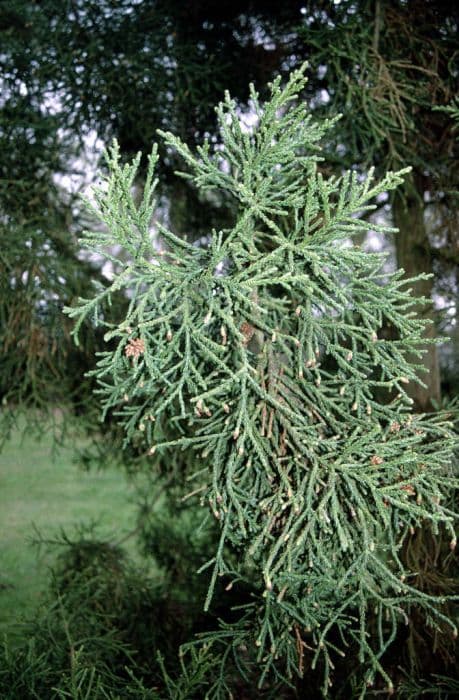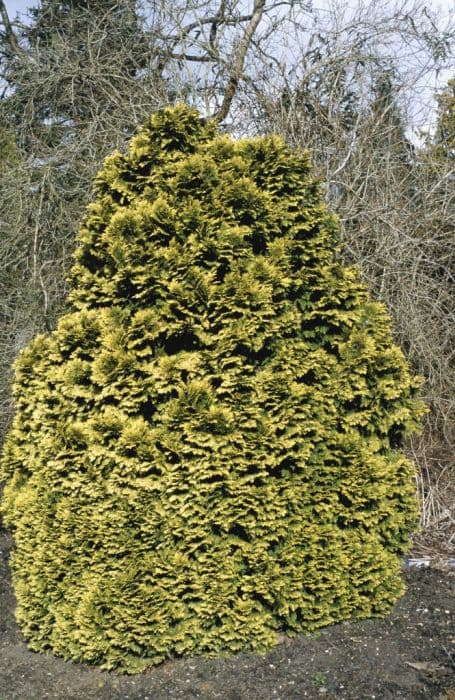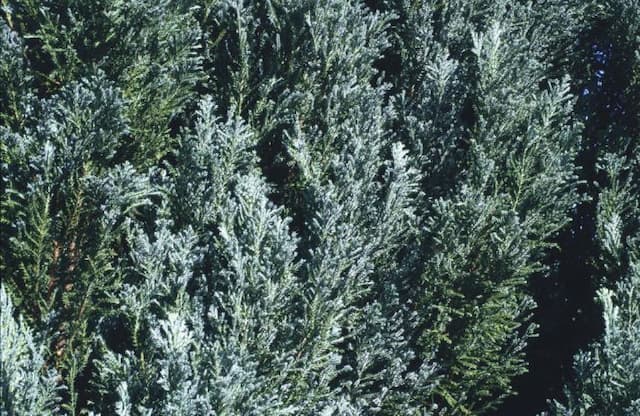Lawson's Cypress Chamaecyparis lawsoniana 'Ellwood's Gold'










ABOUT
The Chamaecyparis lawsoniana 'Ellwood's Gold', commonly known as the Lawson cypress 'Ellwood's Gold', is a distinctive evergreen conifer with a columnar or narrow conical shape. Its foliage is characterized by dense sprays of scale-like leaves that are a striking combination of green and golden yellow. The yellow coloring is more intense on the tips of the foliage, especially when exposed to full sunlight, creating a shimmering effect that stands out in the garden. The leaves themselves are arranged in flattened sprays, which give the plant a textured look and feel. The Lawson cypress 'Ellwood's Gold' also bears small, rounded cones that are inconspicuous and blend into the foliage. The bark of the tree, although not often seen due to the dense foliage, is fibrous with a reddish-brown color that adds to the overall aesthetic when visible. This plant is a popular choice for ornamental use in landscapes where its color can provide year-round interest and it can serve as an attractive hedging or screening option due to its slim, upright growing habit.
About this plant
 Names
NamesFamily
Cupressaceae.
Synonyms
Lawson's Cypress, Oregon Cedar, Port Orford Cedar.
Common names
Cupressus lawsoniana 'Ellwood's Gold', Chamaecyparis lawsoniana 'Elwood's Gold'.
 Toxicity
ToxicityTo humans
The plant commonly known as Lawson's cypress 'Ellwood's Gold' is not typically considered highly toxic to humans. However, some people may experience skin irritation or allergic reactions upon handling the plant, as it can contain skin-irritating compounds. Ingesting parts of the plant can potentially cause gastrointestinal discomfort or more serious health issues, although severe poisoning from consuming Lawson's cypress is not common. If someone has consumed parts of the plant and is exhibiting symptoms, it is important to seek medical attention.
To pets
Lawson's cypress 'Ellwood's Gold' may cause gastrointestinal upset in pets, such as vomiting or diarrhea, if ingested in significant quantities. While it is not listed among the most toxic plants for pets, it is generally recommended to prevent pets from chewing on or ingesting the foliage of any ornamental plants, including Lawson's cypress, to avoid potential digestive issues or more severe health complications. If you suspect your pet has ingested parts of the plant and is showing symptoms, contacting a veterinarian is advised.
 Characteristics
CharacteristicsLife cycle
Perennials
Foliage type
Evergreen
Color of leaves
Gold
Height
4-5 feet (1.2-1.5 meters)
Spread
1-2 feet (0.3-0.6 meters)
Plant type
Tree
Hardiness zones
5-8
Native area
North America
Benefits
 General Benefits
General Benefits- Aesthetic Appeal: Adds visual interest to landscapes with its golden-yellow foliage and upright, conical shape.
- Year-Round Color: Evergreen nature ensures that it provides color in the garden throughout the seasons.
- Low Maintenance: Requires minimal pruning and is relatively easy to care for once established.
- Drought Tolerance: Once established, it can tolerate periods of dry weather, reducing the need for frequent watering.
- Cold Hardy: Can withstand cold temperatures, making it suitable for a range of climates.
- Wildlife Habitat: Provides shelter and nesting sites for birds and other wildlife.
- Privacy Screen: Can be planted in rows to create a natural privacy barrier or windbreak.
- Soil Stabilization: Its root system can help prevent soil erosion on slopes.
- Urban Tolerant: Adaptable to various urban conditions, including pollution and limited soil space.
 Medical Properties
Medical PropertiesThis plant is not used for medical purposes.
 Air-purifying Qualities
Air-purifying QualitiesThis plant is not specifically known for air purifying qualities.
 Other Uses
Other Uses- Model Crafting: The fine, dense foliage of the Lawson's Cypress 'Ellwood's Gold' can be used by hobbyists for creating realistic miniature trees and landscapes for model train setups or architectural models.
- Thematic Gardening: This plant can be a part of a gold-themed garden, offering a striking contrast with its golden foliage against other plants with different hues.
- Privacy Screens: Its dense growth habit makes it ideal for creating living privacy screens or hedges in residential landscaping without needing to resort to fences.
- Topiary: Lawson's Cypress 'Ellwood's Gold' can be shaped into various forms, making it suitable for topiary gardens and artistic garden displays.
- Windbreaks: The plant can be used in rows as windbreaks to protect more sensitive plants or to reduce wind speed on property grounds.
- Sound Barrier: When planted densely, it can help dampen traffic noise and create a quieter garden environment.
- Cultural Significance: Used in certain cultural gardens, such as Japanese gardens, to represent eternal youth owing to its evergreen nature and vibrant color.
- Festive Decor: Branches can be harvested and utilized in winter holiday decorations due to their unique color and texture.
- Photography Backdrop: The golden foliage of Lawson's Cypress 'Ellwood's Gold' provides a striking backdrop for outdoor portrait photography.
- Play Areas: When planted around children's play areas, it can provide both a visual boundary and a safe, soft barrier for play zones.
Interesting Facts
 Feng Shui
Feng ShuiThe Lawson's Cypress is not used in Feng Shui practice.
 Zodiac Sign Compitability
Zodiac Sign CompitabilityThe Lawson's Cypress is not used in astrology practice.
 Plant Symbolism
Plant Symbolism- Endurance: The Lawson's Cypress, often found in rugged landscapes, symbolizes the ability to endure tough conditions or stand firm in the face of challenges.
- Everlasting Life: As an evergreen, the Lawson's Cypress represents immortality and the undying aspect of the soul.
- Protection: Since cypress trees are often planted in cemeteries, they are thought to guard and protect the spirits of the departed.
- Purity: The conifer's clean lines and enduring nature can symbolize purity and the simplicity of truth.
- Tranquility: The Lawson's Cypress's lush greenery and stature bring about a sense of peace and calm, representing serenity.
 Water
WaterThe Lawson's Cypress 'Ellwood's Gold' prefers consistently moist soil but does not tolerate waterlogged conditions. Water this plant once a week with about one to two gallons of water, ensuring the soil is moist to a depth of at least a few inches without being soggy. During hot, dry periods, the frequency may need to increase to maintain moisture levels, whereas in cooler, wetter seasons, watering can be reduced. It's pivotal to adjust your watering schedule based on rainfall and temperature changes to avoid overwatering.
 Light
LightLawson's Cypress 'Ellwood's Gold' thrives best in full sun to partial shade. It should be planted in a spot where it receives at least 4 to 6 hours of direct sunlight each day, while also being protected from harsh, afternoon sun that could scorch the foliage in very hot climates. The morning sun is particularly beneficial as it helps dry dew from the needles, reducing the risk of fungal diseases.
 Temperature
TemperatureLawson's Cypress 'Ellwood's Gold' is hardy and can withstand a wide range of temperatures, making it suitable for various climates. It can survive temperatures as low as -30°F and as high as 90°F, but the ideal temperature range for this plant is between 40°F and 70°F. It's essential to protect the tree from extreme temperature fluctuations, particularly frost damage in early spring if it's not fully hardened off.
 Pruning
PruningPruning the Lawson's Cypress 'Ellwood's Gold' is mainly for shaping and controlling size and is best done in the early spring before new growth starts. Light trimming can also be done in the summer to maintain a neat appearance. Avoid heavy pruning as this plant doesn't respond well to cutting into old wood. Annual thinning of dense growth can help improve airflow and prevent disease.
 Cleaning
CleaningAs needed
 Soil
SoilEllwood's Gold cypress thrives in a well-draining soil mix with a neutral to slightly acidic pH of 6.0 to 7.0. A mix of loamy garden soil, peat, and sand or perlite is ideal to ensure good drainage and aeration.
 Repotting
RepottingEllwood's Gold cypress, typically grown as an outdoor plant, doesn't require frequent repotting. Repot young plants every 2-3 years to encourage growth and prevent root-bound conditions.
 Humidity & Misting
Humidity & MistingEllwood's Gold cypress prefers moderate humidity levels but is quite adaptable and doesn't require specific humidity conditions to thrive.
 Suitable locations
Suitable locationsIndoor
Position in bright, indirect light; avoid dry heat and drafts.
Outdoor
Full sun to partial shade; shelter from strong winds.
Hardiness zone
5-8 USDA
 Life cycle
Life cycle'Ellwood's Gold' Cypress, known as Chamaecyparis lawsoniana 'Ellwood's Gold', begins its life as a seed, often germinating in spring with proper moisture and temperature conditions. Once sprouted, the seedling grows rapidly, developing a distinct pyramidal shape and sprays of yellow-tipped foliage. As a juvenile, the soft textured, scale-like leaves become increasingly yellow-golden, especially when exposed to full sun. Reaching maturity after several years, 'Ellwood's Gold' can attain heights of 10-15 feet, with some specimens growing taller under ideal conditions. In maturity, the tree produces small, round cones that mature in autumn, completing its reproductive cycle. The lifespan of this ornamental conifer can exceed 20 years, during which it provides structure and color in garden settings, with minimal maintenance requirements.
 Propogation
PropogationPropogation time
Spring-Early Summer
Propogation: The Lawson's Cypress 'Ellwood's Gold', typically propagated during the late summer to mid-fall, finds its most popular method of propagation through softwood cuttings. This involves taking cuttings of new growth that has not yet hardened and become woody. To propagate, you would cut sections of the stem around 4 to 6 inches (approximately 10 to 15 centimeters) long, making sure each cutting has a few sets of leaves. Dip the base of the cutting in rooting hormone to encourage root development and insert the cutting into a moist potting mix. Keeping the cuttings under high humidity and in indirect light will help them to root, which usually takes several weeks. After the cuttings have rooted and show signs of growth, they can be transferred to individual pots to grow on before eventually being planted out.









